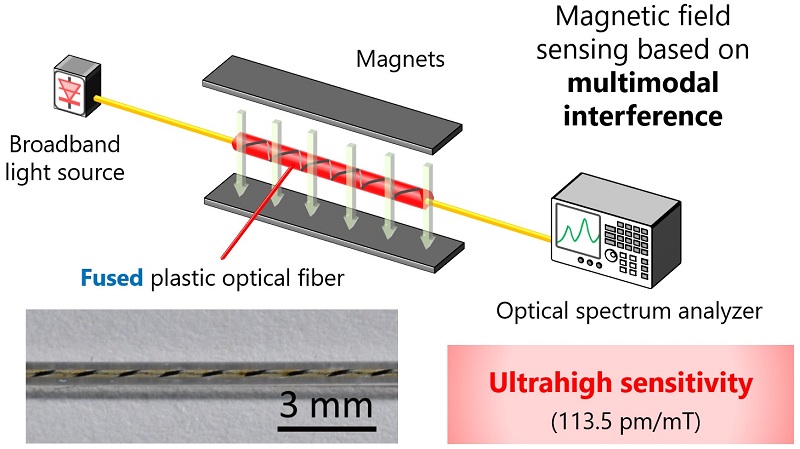An international collaboration has found new use for damaged optical fibers, in measuring magnetic fields. Researchers have developed a sensor design that is significantly more sensitive than conventional fiber optic methods of magnetic detection, relying on the “fiber fuse effect” that occurs when high-powered light is injected into an optical fiber with tight bends, bad connectors, and other less-than-ideal conditions.
When high-powered light is injected into such a fiber, the optical energy becomes trapped in the core of the fiber, leading to an optical discharge that moves toward the light source. The effect damages the fiber in the process.
The team from Yokohama National University, Federal University of Espírito Santo (Spain), Shibaura Institute of Technology (Japan), Tokyo Institute of Technology, and the University of Aveiro (Spain) found that when the fiber is made up of polymer, the effect resulted in an electrically conductive carbonized path, enabling the interactions needed to react to magnetic fields.

A magnetic field sensor based on multimodal interference in a 'fused' polymer optical fiber achieves an ultrahigh sensitivity of 113.5 pm/mT. Courtesy of Yokohama National University.
“The interactions between the magnetic field and the carbonized — or damaged — regions can lead to variations in optical parameters in the fibers,” said lead author Arnaldo Leal-Junior, a professor in the graduate electrical engineering program at Federal University of Espírito Santo. “By sandwiching a fused polymer fiber between two silica single-mode fibers and inducing what we call multimodal interference, a fiber optics magnetic field sensor can be implemented.”
An experiment demonstrated that the sensor is capable of detecting a small magnetic field change of 45 microtesla (µT), which is several hundred times more sensitive than the 20 millitesla (mT) detection by a conventional fiber optic method. A magnetic field of about 100 µT is measured an inch away from a standard kitchen microwave during operation.
“Magnetic field sensors are often required in handling various apparatuses in electrical power systems, such as generators and motors,” said co-author Yosuke Mizuno, an associate professor at the Faculty of Engineering at Yokohama National University.
The newly developed sensor can be easily fabricated at low cost, and the approach paves the way for a novel recycling option by salvaging fused polymer optical fibers for use in magnetic field sensors, Leal-Junior said. Beyond improving device sensitivity and measurement accuracy, the researchers said they plan to use the approach to demonstrate electric field sensing.
The research was published in Advanced Photonics Research (www.doi.org/10.1002/adpr.202000078).